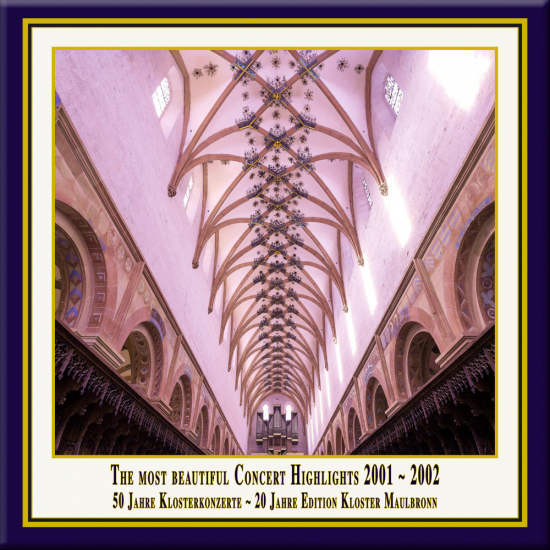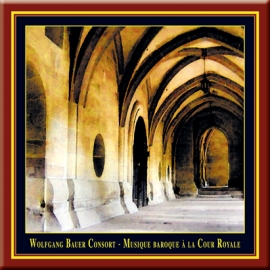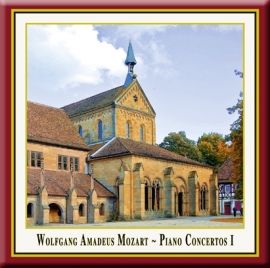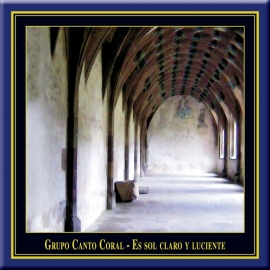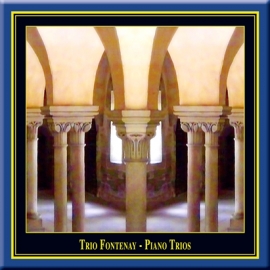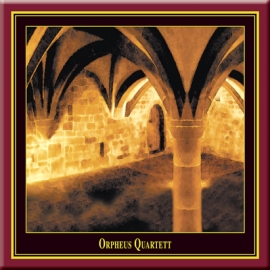Vol. 04: The most beautiful Concert Highlights 2001-2002
The most beautiful Concert Highlights
from Maulbronn Monastery 2001-2002
The 50th Anniversary of the Maulbronn Monastery Concerts
Anniversary Series, Vol. 4
Highlights from:
Giacomo Puccini:
Messa di gloria
(May 19 & 20, 2001)
Giuseppe Torelli:
Trumpet Sonata in D Major, G. 1
Johann S. Bach:
Sonata No. 3 for Violin & Harpsichord in E Major, BWV 1016
Johann S. Bach:
Brandenburg Concerto No. 2 in F Major, BWV 1047
(May 2001)
Wolfgang A. Mozart:
Piano Concerto No. 17 in G Major, K. 453
Wolfgang A. Mozart:
Piano Concerto No. 23 in A Major, K. 488
(September 14, 2001)
The South American Christmas Concert:
"Es sol claro y luciente"
(June 1, 2002)
Joaquin Turina:
Piano Trio No. 1 in D Major, Op. 35
Ludwig van Beethoven:
Piano Trio in E-Flat Major, Op. 70, No. 2
(June 14, 2002)
L.v.Beethoven:
"Rasumovsky String Quartet No. 2" E Minor, Op. 59/2
(June 20, 2002)
Live recordings from the German
UNESCO World Heritage Site Maulbronn Monastery
HD Recording · DDD · Duration: c. 99 Minutes
Digital Album · 17 Tracks · incl. Digital Booklet


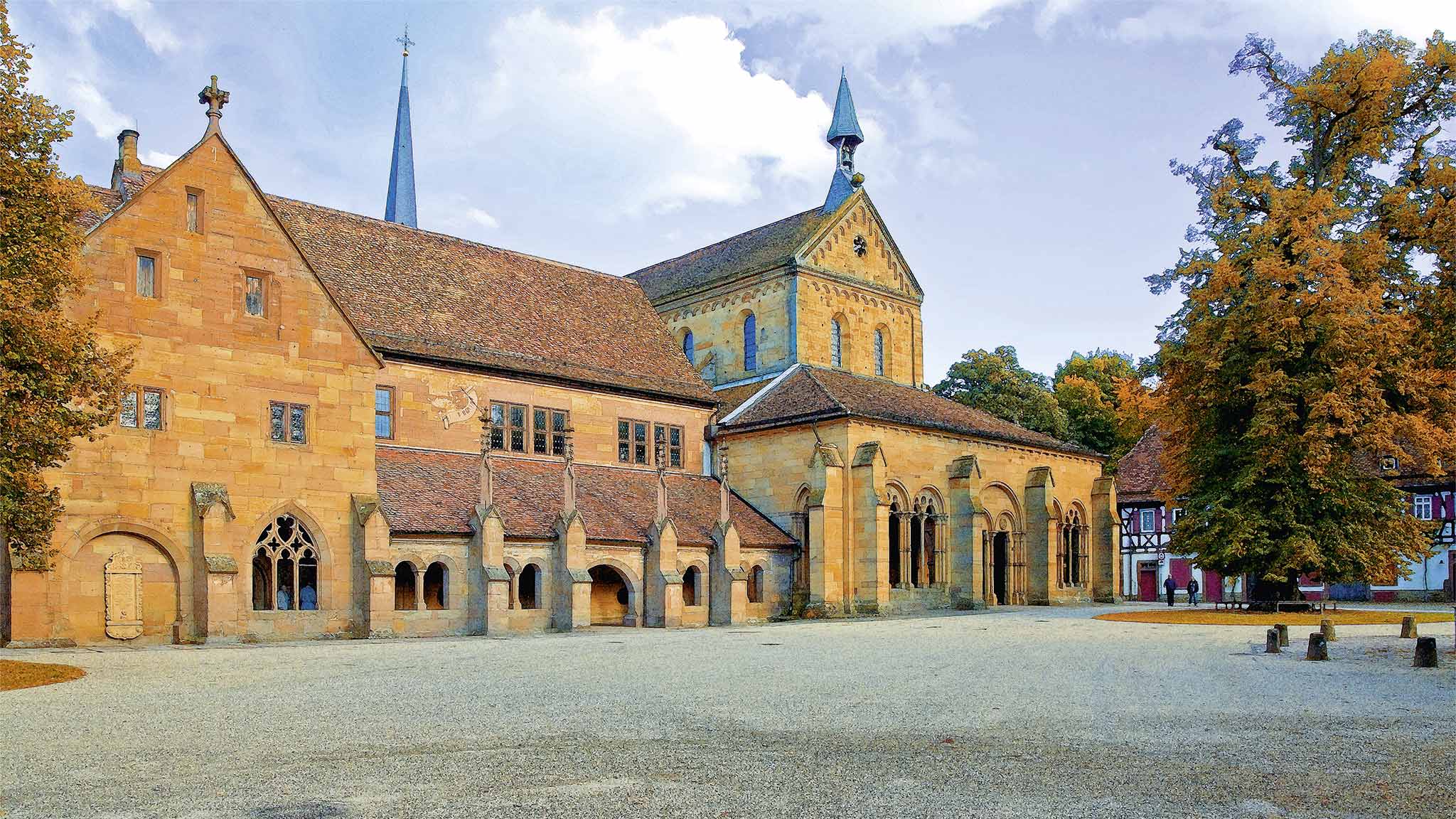
W
e have been documenting for 20 years the concerts at the UNESCO World Heritage Maulbronn Monastery. The concerts supply the ideal conditions for our aspirations. It is, above all, the atmosphere of the romantic, candle-lit arches, the magic of the monastery in its unadulterated sublime presence and tranquillity that impresses itself upon the performers and audience of these concerts. Renowned soloists and ensembles from the international arena repeatedly welcome the opportunity to appear here - enjoying the unparalleled acoustic and architectural beauty of this World Heritage Site, providing exquisite performances of secular and sacred music, documented by us in our Maulbronn Monastery Edition.
Josef-Stefan Kindler & Andreas Otto Grimminger, K&K Verlagsanstalt
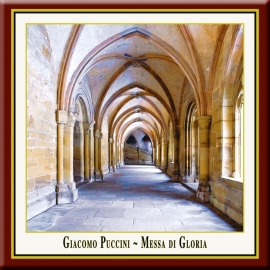
Messa di gloria by Giacomo Puccini (1858-1924)
Imagine you are living in 19th century Italy, you're 22 years old and studying music at the Conservatory in Lucca. In just a few weeks you will submit your first big musical composition to the Conservatory's Board of Directors: your final year project for your degree, the highlight of your young life... As I see it, Giacomo Puccini's "Messa di Gloria" represents a high point in his creative work - because can you really say this is "only" one of his early works? True, you sense the brilliance, the rapture and, indeed, a little of the lack of respect typical of youth - but in actual fact, this composition is simply too beautiful for a mass back in those days. It reflects the young artist's total passion and dedication. Unlike many people who see the "Gloria" as the climax of this composition, I personally feel that the real climax is the "Agnus Dei". And the fact that it reappears later - and almost unchanged - in the opera "Manon Lescaut" is surely no coincidence. (Josef-Stefan Kindler)
Although music scholars have been aware of the "Messa di Gloria" by Giacomo Puccini (1858-1924) for a considerable time, the piece only began to appear in concert programmes relatively recently. The score was in fact not published until 1951. Since then the work has been known generally as the "Messa di Gloria". It was first performed on July 12th, 1880 at the Festival of San Paolino, the patron saint of bells, who is particularly revered in this part of Tuscany. This public performance brought the young composer general recognition. Puccini incorporated two other pieces of church music into the score of the Messa - a motet and a Credo that he had composed for the same festival in 1878. The entire composition had originally been conceived as a large choral work, but the final version is for two solo voices, a four-part choir and a large orchestra. The Messa is thus the first comprehensive work by Puccini to follow the solid musical traditions of his family and deliberately use the "modern" methods of expression in vogue at the time. Puccini used his expertise in festive choral music and in adhering to the strictest conventions of counterpoint, and combined it with his own personal concept of a style for church and an innate feeling for melody that was present in him from the start. There is also a certain style to the sound that foreshadows the extraordinary mastery of orchestration apparent in his late works. Puccini was particularly fond of this early composition, proof that he attached particular importance to it. Echoes of the "Messa" reappear later in Puccini's operas, particularly in "Edgar" and "Manon Lescaut". In fact, the "Madrigale" in Act 2 of Manon contains almost the entire "Agnus Dei", with only very few structural changes. Bearing all this in mind, it is no wonder that Puccini's Messa is so highly appreciated today.
The concert: "Musique baroque à la Cour Royale"
The Wolfgang Bauer Consort was founded in 1994. Its primary occupation is the performance of authentic Baroque chamber music pieces. The English Baroque term "Consort" accurately describes an ensemble comprising one or two soloists and a continuo of cello and harpsichord. The Consort's open structure provides the fundament for the comprehensive array and musical diversity of this performance in the monastery church, whose outstanding acoustics and atmosphere are able to document the complete range of Baroque virtuosity. An addition is the Sanssouci Trio, a work written by Bernhard Krol especially for the Wolfgang Bauer Consort. The piece underlines the flexibility and power of musical expression of this traditional ensemble in many genres, up to and including contemporary compositions. Wolfgang Bauer, the winner of, among others, the Munich ARD competition, is one of the leading international trumpet soloists. He is a professor at the Stuttgart University of Music and Performing Arts and has had consecutive engagements as solo trumpeter with the Munich Philharmoniker, the Frankfurt Radio Symphony Orchestra and Bavarian Radio's Symphony Orchestra.
The "Vienna piano concertos" between 1782 and 1786 are seen as the most eminent instrumental compositions of Wolfgang Amadeus Mozart´s life work. He created a new musical form through the use of comprehensive musical ideas in reference of the themes, the originality and the equality of the interaction between soloist and orchestra. That is an extraordinary achievement of Mozart particularly in this part of his life - maybe as a result of his failed opera plans before - in view of the many concerts he played as one of the most asked pianists of Vienna and the multitude of students he taught during this period. It is documented, for example, that Mozart performed in the genesis year of the g major concerto (1784) at least 23 concerts during a period of 46 days. He also composed 6 piano-concertos and taught a stately quantity of students during the same year... Therefore these two works are carried by love of life cause of this outer success - profound but life-affirmatively, sometimes melancholic, yes even tragic, however by no means resigning. Exactly these disputes with the intellectual density and psychological dimension of Mozart's works make Christoph Soldan's interpretations uniquely. Soldan studied with Prof. Eliza Hansen as well as Christoph Eschenbach at the Hamburg music university and attained his international success through a concert tour with Leonard Bernstein in the summer 1989. Since than he performs concerts as soloist of various renowned orchestras in Europe, the USA, Mexico and Japan. In addition to technical perfection, it is his concentration on the depth of the interpretation and the atmospheric transparency, which makes Soldan´s concerts very valuable. Christoph Soldan combines a long-standing cooperation with the Polish conductor Pawel Przytocki. Przytocki works since 1999 as a constant guest conductor of the radio symphony orchestra Krakau and perfomed with the Budapest Concert Orchestra, the Orchestra Sinfonica de Xalapa in Mexico, the Real Philharmonia de Galicia in Spain and the Cappella Istropolitana. The Capella Istropolitana with his transparent string sound in accordance with the historical performance practice is virtually predestined for these concerti. This orchestra is seen as one of the most prestigious ensembles for historical music and look back to more than 70 cd-productions - two these releases were honored with platinum.
Except for specialists, very little is known about the musical aspects of colonial Latin America. Following the arrival of conquerors and colonizers, an extremely important cultural symbiosis slowly begins to take shape. This process extends all the way to the end of the 18th century and, in some regions, it lasts up to the early 19th century along with the wars of independence. This period witness the development of a large and rich heritage in architecture, painting, sculpture, and literature. The Cuzco paintings or the works of Aleijadinho in Brazil, suffice to recognize important peculitarities. A similar process takes place with the music. Just as the University of Salamanca was the model for New World institutions of higher learning, the Music Chapel of Seville Cathedral became the paradigm for those to be established in the key cities of viceroyalities overseas. They received important musicians, printed music or manuscript copies, instruments and theoretical writings. Nearly the entire corpus of this music can be found in ecclesiastical repositories and are associated with the church and its celebrations. However, few examples of profane works remain. Several researchers have devoted themselves to explore these centuries. At the same time they have started a search for documents of the period: data written down by priests in church-books, listings of church expenditures which includes singers and interpreters, instruments acquired an celebrations in which they took part. Their study and analysis, as well as the chronicles of priests and travellers, teach us about the norms that ruled music in American Chapels, their composers and the bulk of their repertoire. In Mexico. Lima, Sucre or Cuzco, the Chapel Master guided his "schola", controlling its daily practices while, at the same time, composing new works for successive festivities. We should recall that most choral singers, singing and dancing choir boys and interpreters as well as composers were indigenous, and in Brazil, mulattos. The repertoire included a variety of sources: books printed in and regularly received from Europe, the works of resident maestros, often of great value, and later on, works of native composers formed in Latin America. We can identify three key musical periods. The first period in Mexico, with "a capella" polyphony which recalls Spanish Renaissance. there we can find Liturgical works and Christmas carols, as well as toys, melodies and pitaresque ballads.
The Piano Trio No. 1 in D Major, Op. 35, by Joaquin Turina (1882-1949)
A work by the Spanish pianist and composer Joaquin Turina from the year 1926 - a piece previously unrecorded by the Trio Fontenay. Together with Manuel de Falla, Turina is held as the most outstanding representative of the modern Spanish school, which was motivated by French Impressionism, but in its melody, however, is attached to the folk music of Andalusia.
The Piano Trio in E-Flat Major, Op. 70, No. 2, by Ludwig van Beethoven (1770-1827)
Carl Czerny, composer and student of Beethoven, says of this work, "this trio is no less great or original than its successor (Trio D-major, op 70 No. 1), but it is of a very different, less serious character." The trio in e-flat major was composed during the summer of 1808 immediately after the Sixth Symphony, and applies foreseen traits to Romanticism. Beethoven expands his realm of expression here in two somewhat converse directions: both in a seemingly romantically tonal colourfulness, and towards the inclusion of classic style elements by means of a stricter introduction.
This String Quartet was the second of three of his "Razumovsky" cycle of string quartets, and is a product of his "middle" period. He published it in 1808. It is in four movements: I. Allegro - II. Molto adagio (Si tratta questo pezzo con molto di sentimento) - III. Allegretto (with the second section marked Maggiore - Theme russe) - IV. Finale. Presto. According to Carl Czerny, the second movement of the quartet occurred to Beethoven as he contemplated the starry sky and thought of the music of the spheres (Thayer, Life of Beethoven); it has a hymnlike quality reminiscent of a much later devotion, the "Heiliger Dankgesang" hymn to the Divine in the Quartet Op. 132. The scherzo movement of the quartet, the third movement (allegretto), uses a Russian theme also used by Modest Mussorgsky in Boris Godunov, by Anton Arensky in his String Quartet No. 2 in A Minor, and by Sergei Rachmaninoff in his 6 Morceaux for Piano Duet, Op. 11. The original song, "Glory to the Sun", was recorded by Nikolay Lvov and Jan Prac; sheet music was published in 1790 (second edition 1806), verses in the 1770s. However, Beethoven used it in an ungentle way. According to Kerman, "It sounds as though Count Razumovsky had been tactless enough to hand Beethoven the tune, and Beethoven is pile-driving it into the ground by way of revenge." In an extremely unusual example of melodic setting prior to the 20th century, portions of the tune with strong tonic harmonic leanings are harmonized with the dominant, and vice versa; the harmonic clash is harsh, and many listeners have found this portion of the quartet to be quite amusing, especially as contrasted with the prosaic, almost "exercise-book" counterpoint which precedes it (another example of Beethoven parodying a student counterpoint exercise can be found in the scherzo of the Quartet No. 10, opus 74). (From Wikipedia, the free encyclopedia)
P
ublishing Authentic Classical Concerts entails for us capturing and recording outstanding performances and concerts for posterity. The performers, audience, opus and room enter into an intimate dialogue that in its form and expression, its atmosphere, is unique and unrepeatable. It is our aim, the philosophy of our house, to enable the listener to acutely experience every facet of this symbiosis, the intensity of the performance, so we record the concerts in direct 2-Track Stereo digital HD. The results are unparalleled interpretations of musical and literary works, simply - audiophile snapshots of permanent value. Flourishing culture, enthralling the audience and last but not least also you the listener, are the values we endeavor to document in our editions and series.
The concerts at the UNESCO World Heritage Maulbronn Monastery supply the ideal conditions for our aspirations. It is, above all, the atmosphere of the romantic, candle-lit arches, the magic of the monastery in its unadulterated sublime presence and tranquillity that impresses itself upon the performers and audience of these concerts. Renowned soloists and ensembles from the international arena repeatedly welcome the opportunity to appear here - enjoying the unparalleled acoustic and architectural beauty of this World Heritage Site, providing exquisite performances of secular and sacred music, documented by us in our Maulbronn Monastery Edition.
The concert grand piano is incontestably the king of instruments. We could now wax lyrical about its incomparable dynamics and go into its ability to go from the tenderest of sounds in a soft minor key to the magnificent power of a fortissimo, or I could rhapsodise about its impressive size and elegance. But what makes this instrument really fascinating is its individuality, since each one is unique in itself - created by a master. A concert grand has a life all of its own that a virtuoso can really "get into" and hence bring the work of the composer to life. In our Grand Piano Masters Series, we get into the character and soul of the concert grand piano and experience, during the performance itself, the dialogue between the instrument, the virtuoso and the performance space.
Andreas Otto Grimminger & Josef-Stefan Kindler, K&K Verlagsanstalt
Giacomo Puccini (1858-1924):
Messa di gloria
performed by the Maulbronn Cantor Choir (Kantorei Maulbronn)
and members of the SWR-Symphony-Orchestra Baden-Baden and Freiburg,
conducted by Jürgen Budday
on May 19 & 20, 2001
1. Kyrie [6:07]
Chorus
2. Gloria [19:55]
Tenor Solo & Chorus
Soloist: Willi Stein (Tenor)
3. Agnus Dei [2:24]
Tenor Solo, Bass Solo & Chorus
Soloists: Willi Stein (Tenor) & Thomas Pfeiffer (Baritone)
Excerpts from the concert
Musique baroque à la Cour Royale
performed by the Wolfgang Bauer Consort
in May 2001
Giuseppe Torelli (1658-1709):
Trumpet Sonata in D Major, G. 1
4. III. Grave [2:18] · 5. IV. Allegro [1:28]
Johann Sebastian Bach (1685-1750):
Sonata No. 3 for Violin & Harpsichord in E Major, BWV 1016
6. I. Adagio [4:21]
Johann Sebastian Bach (1685-1750):
Brandenburg Concerto No. 2 in F Major, BWV 1047
7. I. Part I [4:35]
Wolfgang Amadeus Mozart (1756-1791):
Piano Concertos Nos. 17 & 23
performed by Christoph Soldan (Piano)
and the Cappella Istropolitana,
conducted by Pawel Przytocki
on September 14, 2001
Piano Concerto No. 17 in G Major, K. 453
8. II. Andante [9:10]
Piano Concerto No. 23 in A Major, K. 488
9. III. Allegro assai [8:00]
Highlights from the South American Christmas choral concert
Es sol claro y luciente
"He is the brilliant and luminous sun",
performed by the Grupo Canto Coral Buenos Aires
(Chamber Choir and Baroque Orchestra),
conducted by Nestor Andrenacci
on June 1, 2002
10. Dennos licencia señores [2:14]
"Allow us, Lords, to sing and dance"
Cachua · Anonymous Dance of the Indios
11. Niño il mijor quey logrado [1:28]
"Greatest child, which I have found"
Cachua · Anonymous Dance of the Indios
12. Dame albriçia mano Anton [3:29]
"Congratulate me, Brother Anton, for Jesus has been born in Guinea"
by Gaspar Fernandes (c. 1570-1629)
Excerpts from the concert
Piano Trios by Turina & Beethoven
performed by the Trio Fontenay:
Michael Mücke (Violin) · Jens Peter Maintz (Cello) · Wolf Harden (Piano)
on June 14, 2002
Joaquin Turina (1882-1949):
Piano Trio No. 1 in D Major, Op. 35
13. II. Theme et Variations: Andante - Allegro - Andante [7:59]
Ludwig van Beethoven (1770-1827):
Piano Trio in E-Flat Major, Op. 70, No. 2
14. II. Allegretto [5:14] · 15. IV. Finale. Allegro [7:51]
Excerpts from the concert
String Quartets by Veress & Beethoven
performed by the Orpheus String Quartet:
Charles-André Linale (1st Violin) · Emilian Piedicuta (2nd Violin)
Emile Cantor (Viola) · Laurentiu Sbarcea (Cello)
on June 20, 2002
Ludwig van Beethoven (1770-1827):
String Quartet in E Minor, Op. 59, No. 2
"Rasumovsky Quartet No. 2"
16. III. Allegretto [6:47] · 17. IV. Finale: Presto [5:57]
Sound & Recording Engineer: Andreas Otto Grimminger
Production & Mastering: Andreas Otto Grimminger & Josef-Stefan Kindler
Photography, Artwork & Coverdesign: Josef-Stefan Kindler

